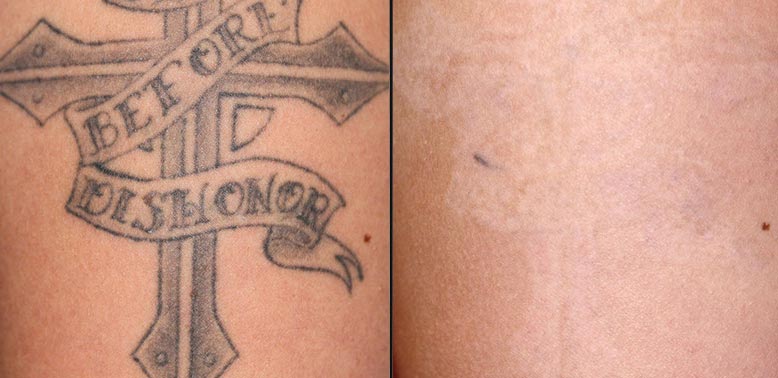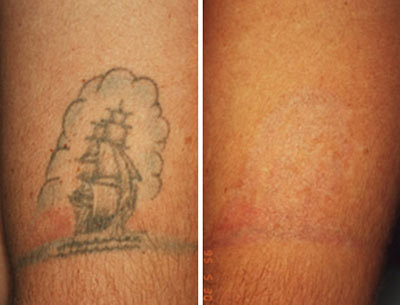Laser Tattoo Removal
Lasers work by directing energy toward ink in the skin with highly concentrated colored light beams. These laser beams break up ink particles into tiny fragments, which are later cleared up by the body’s scavenging cells. This process of fragmenting the ink particles requires numerous sessions depending on the depth of the ink level. The procedure is bloodless and no incisions are made. The laser selectively targets the pigment of the tattoo without damaging the surrounding skin. With deeper penetration of the skin and multiple sessions, however, the heat generated by the lasers may cause pain and blister formation. Even though laser technology is refined, the chance of scarring is always present with multiple treatments. This is not only true for laser tattoo removal, but with nearly all tattoo removal methods.
Individuals with fair skin and superficially placed tattoos on the arms, chest, buttocks or legs are the best candidates. Tattoos on dark-skinned individuals, or tattoos on the ankles or fingers (areas where there is less body fat), are the most difficult to treat and results are more variable. A thorough discussion with a tattoo removal specialist can better determine the potential success rate of laser tattoo removal for any given tattoo and skin type. Consulting with a professional and reputable tattoo removal specialist who is experienced and understands the procedure is important to ensure proper treatment and candidacy.
Unfortunately, not all tattoos can be removed completely, but the majority can be. Tattoos are meant to be permanent, and with recent ink technology and professional tattoo artists improving their skills, tattoos imprinted in the last decade are very difficult to remove. Even with the best technique, some residual scarring remains in a few cases.
Complete removal of a tattoo is based on several things. The size, location, application, age of the tattoo (newer tattoos are generally more difficult to remove), and color of the tattoo all factor in, as well as the health of the patient. A patient’s health is a determining factor because it will determine how well the body is able to heal after the procedure.
Unfortunately, tattoos are painful when they are placed on the skin, and they are just as painful when they are removed. The lasers generate rapid pulses that may feel different to each patient, but are generally uncomfortable and feel like the snap of a rubber band to the skin. To minimize the pain, the physician will recommend taking Tylenol a few hours before the procedure. Pain medications that thin blood and promote bruising are not recommended. To further decrease the pain, the physician may apply a local anesthetic ointment on the tattoo a few hours before the procedure. In some cases, the physician may inject a local anesthetic into the tattoo before the procedure.
Laser treatment usually does not take more than a few minutes, yet this time frame varies greatly depending on the tattoo. However, multiple sessions are required to remove most tattoos. The multiple sessions are usually split over 4-8 week periods, depending on the size and complexity of the tattoo.
Side effects of laser procedures are generally few but may include hyperpigmentation (excessive color) or hypopigmentation (excessive fading) of the skin. Other possible side effects include infection and a small chance of permanent scarring. The area may appear sunburned for a few months, and ultimately this will pass.


